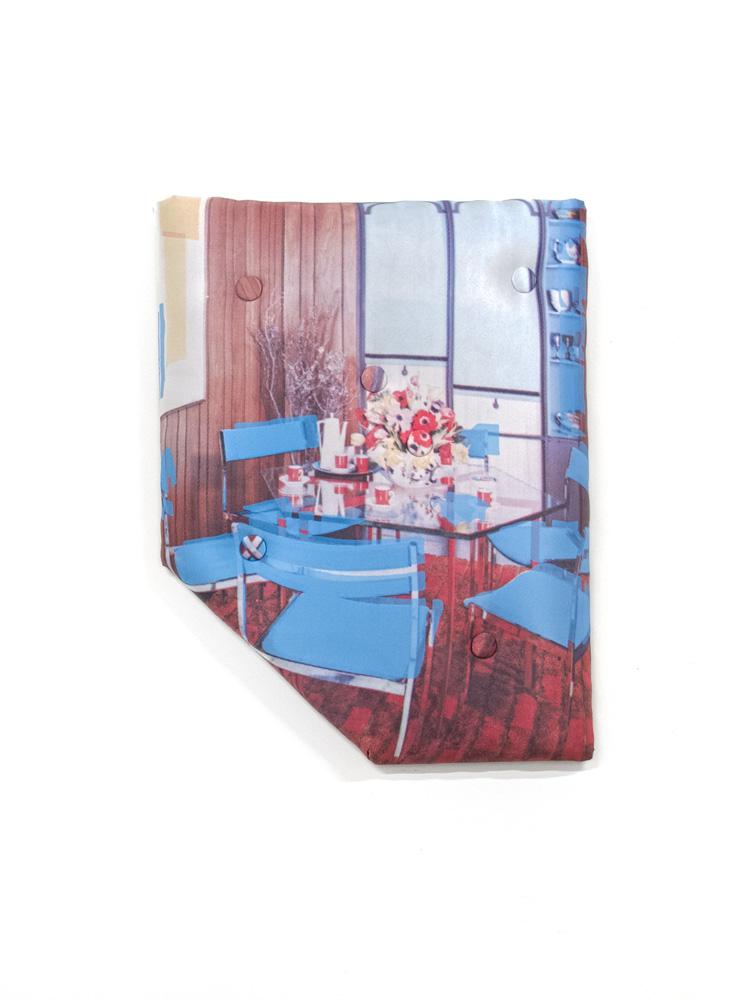It seems there is such an interest right now in formalism and abstraction that work of a more representational or corporeal ilk comes across as a surprise—and a pleasant surprise at that.
“Softening the Corners,” a group show at Birch Contemporary, offers a few such unexpected diversions.
Among them is Josh Thorpe’s Third Toga (1:1). At first glance, this pale-pink wall painting may seem abstract—that is, a simple semi-circle—but it is also, as its title suggests and exhibition text elaborates, a to-scale representation of a Roman toga. The fact that it “wraps” around an interior wall underlines the connection between architectural space and the body in a light (but effective) way.
Also calling attention to the position of bodies and structures in space are Thorpe’s The Park prints. One print greets viewers as they enter the gallery, while the other is found on the opposite side of the wall on which the first hangs. Seeing one of these forested landscapes alone—and then, unexpectedly, another as one moves a bit deeper into the gallery—generates an uncanny feeling of the wall as both subject and object, or at least as an element with oft-overlooked physicality.
Lili Huston-Herterich’s upholstered cushions bear bright, ultra-technicolour images of interiors from the 1950s. These highly tactile yet representational works appeal, for me, to a sense of nostalgia and memory, evoking the kitsch décor of past eras as well as childhood sensations of playing with the buttons on tufted cushions and chairs.
The prospect of seeing several of Colleen Heslin’s works in person was what attracted me to the show in the first place. After all, Heslin’s use of sewn and dyed fabric to make award-winning paintings integrates traditions of feminized craft neglected in the art-historical canon—a gesture I appreciate.
But once in situ, I found I was drawn to Heslin’s more sculptural works in rope, metal and (yes) nail polish, rather than her 2-D sewn and collaged abstractions. Untitled (Pink & Purple) comes across as a loose drawing in space. And the use of nail polish as material evoked, for me, an even closer connection to the body than the use of old clothing and textiles.
After I viewed the exhibition, curator Corrie Jackson explained to me that a central work in the show is Renée Van Halm’s Privacy Screen. Halm is the only artist in the show actually represented by Birch Contemporary, and this work is from 1997—rather than 2014, like the other works in the show—reflecting Halm’s status as an artist of a more senior generation.
Privacy Screen both imitates and references the shoulder-height screens in Mies van der Rohe’s Farnsworth House, which was built in 1951. Farnsworth House’s original owner eventually abandoned the structure for several reasons, one being a sense of constant exposure in the glass-walled home and another being the fact that it was not well adapted to the local landscape, being subject to severe flooding from a nearby waterway.
One side of Halm’s structure—the more extruded or “exterior” side—is painted black, with a representation of Farnsworth house in greys and whites along the top edge. The other side of the structure—the more enclosed or “interior” side—is painted bright red, creating a powerful visual contrast that at its most elemental might be framed as blood-versus-brain.
Farnsworth House was born of a beautiful idea, and it is, I take it, a beautiful structure—but it is not amenable to actual human habitation or nurturance, at least as far as most humans are concerned.
Exiting this exhibition (which included a few “misses” as well as the aforementioned “hits”), I wondered how much art made today is of a similar ilk—great as an idea or visual experience, but less amenable to corporeal and emotional needs.
This article was corrected and clarified on August 14, 2014. The original failed to mention that Heslin’s sculptural works include metal as a material, and the lead caption omitted mention of a partial view of Josh Thorpe’s work.









